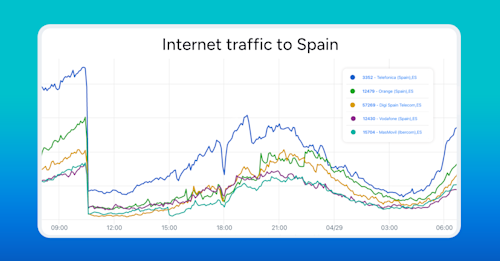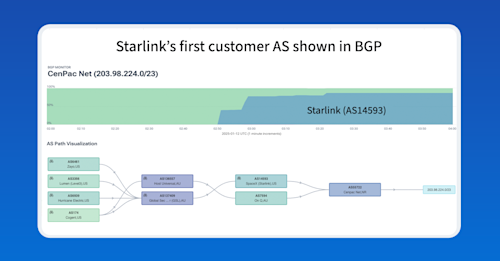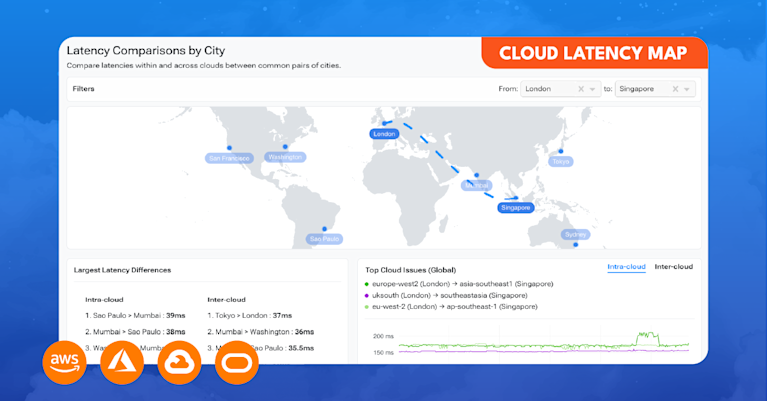Lunes Sin Luz: Spain and Portugal’s Historic Outage


Summary
On Monday April 28, 2025, the countries of Spain and Portugal experienced a widespread electrical blackout of historic proportions. In this post, we look into the internet outages caused by the loss of power including impacts outside of the Iberian Peninsula and to Starlink service in Spain.
At midday on Monday, April 28, the lights went out across the Iberian Peninsula. In what is now being described as the largest electrical outage ever to hit Spain and Portugal, modern life came screeching to a halt. Internet service was among the casualties of a power blackout that is, at the time of this writing, yet to be fully explained.
According to Kentik’s aggregated traffic data, internet service in these countries suffered a massive outage beginning at 10:34 UTC. Now, days later, Spain and Portugal continue to restore services after an unprecedented collapse of their power grid.
What happened?
Big picture
Let’s begin at the macro level. According to Kentik’s traffic data, we observed traffic volume drops on Monday (measured in bps) of 68% and 74% for Spain and Portugal, respectively. The plots of traffic volumes for the two countries on April 28 are illustrated below.

Another perspective of Monday’s blackout comes from Georgia Tech’s IODA (Internet Outage Detection and Analysis) monitoring tool, which provides its unique views for Spain and Portugal.
Pictured below, the tool’s visualization shows steep declines of successful pings (blue) into Spain, along with a dropoff of unsolicited traffic (orange) from Spain shortly after 10:30 UTC. Alternatively, the number of BGP routes in green only experiences a minor decline later in the day, underscoring the fact that BGP routes are a necessary but not sufficient condition for internet connectivity. A diverse set of data sets are often needed to completely understand an outage.
Note the curious dip at 5:50pm (17:50) UTC, which aligns with the brief dip at the same time in the traffic curve for Spain above. Perhaps we’ll learn in the near future what caused this momentary backslide during the recovery, because it appears in nearly every graph involving Spain (but not Portugal).

Our friends over at Cloudflare have also shared their views of the outages, which include changes in bandwidth and latency.
Individual providers
Based on Kentik’s aggregate NetFlow data, the visualizations below illustrate traffic to the top destination ASes in Spain and Portugal on the day of the outage. Following a precipitous dropoff, the plots continue to exhibit a diurnal curve from the few parts of the country lucky enough to maintain connectivity.


Starlink in Spain
Perhaps surprisingly, our data suggests that the popular satellite service Starlink (AS14593) was also impacted in Spain from 16:11 UTC on April 28 to 04:21 UTC the following day. Below is a visualization of aggregate traffic to Spain via Starlink (similar observation in IODA).

And this impact is also observable in BGP. Starlink’s Geoip file includes 26 entries for Spain, including these two:
188.92.252.0/24,ES,ES-MD,Madrid,
188.92.253.0/24,ES,ES-MD,Madrid,This address space is routed as 188.92.252.0/23 and served out of Starlink’s PoP in Madrid mdrdesp:
0.252.92.188.in-addr.arpa domain name pointer customer.mdrdesp1.pop.starlinkisp.net.
In Kentik’s BGP visualization below, we can see changes in routing among AS14593’s upstreams at the time of the drop of Starlink traffic at 16:11 UTC. Despite the shift to new transit providers, traffic to this particular range of IP addresses ceased for over 16 hours.

There is the possibility that Starlink customers in Spain were diverted to PoPs outside of Spain using non-Spanish IP addresses without a loss of service, but that would make it nearly impossible to track. Regardless, Starlink’s infrastructure in Spain did appear to be impacted by the outage.
An effective BGP configuration is pivotal to controlling your organization’s destiny on the internet. Learn the basics and evolution of BGP.

Impacts outside of Spain and Portugal
Morocco
It wasn’t just countries on the Iberian Peninsula that were affected by the historic outage. Telxius, the international arm of Telefonica, is a global carrier that provides service in Africa, South America, and its home continent of Europe.
Just across the Strait of Gibraltar, Maroc Telecom (AS6713 and AS36903) felt the impact of the Iberian blackout. In the graphic below, traffic destined for the Moroccan incumbent experienced the Spanish traffic dip at 17:50 UTC as well as the loss of transit from Telxius and sporadic drops in traffic volume.

Orange Maroc (AS36925) felt the impact more severely, according to our aggregated NetFlow. Below is a graphic capturing the loss of traffic by transit source. AS36925 lost all of its transit providers and briefly reverted to service from Maroc Telecom (AS6713). IODA also dramatically captures the impact here.

Angola
Portugal is a popular landing site for submarine cables serving the west coast of Africa. As a result, we saw a few impacts as far away as Angola, over 5,000km to the south.
Edgoo Networks (AS6424) is a Portuguese provider that lists ZAP Angola as one of its customers. At 15:09 UTC, ZAP lost transit from Edgoo (circled below).

Conclusions
Monday’s power outage on the Iberian Peninsula was one of the largest in European history. The internet cannot operate without electricity, and when power goes out, so do all of the conveniences of today’s digitized society.
While we wait for the investigation into the root cause of the outage to conclude, it is worth reflecting on how we can build resilient networks that continue to operate in the face of a widespread electrical outage. The internet is a critical service with the power to save lives during severe emergencies.
Update: May 2, 2025
After publishing this blog post yesterday, we were able to confirm that Starlink customers in Spain were, in fact, diverted to Starlink PoPs outside of Spain using non-Spanish IP addresses without the loss of service (assuming they could still power their dishes).
We did this by collecting the traffic destined for IP ranges served by Starlink PoPs in Madrid, London, and Milan over the course of April 28. Illustrated below, the drop in traffic to the PoP in Madrid occurred simultaneously with upticks in traffic to the PoPs in London and Milan as Spanish Starlink customers were reassigned IP addresses from those locations to maintain a connection. Due to the distances involved, some of these diversions must have been facilitated by Starlink’s laser inter-satellite links (LISLs).

Starlink’s PoP in Madrid serves more than just Spain. So when traffic had to be diverted to other PoPs, it (transparently?) impacted customers in some far off locations. Cape Verde is a remote island country off the coast of West Africa. It also approved the use of Starlink back in December.
Like all of Spain, Cape Verde is normally served via the Starlink PoP in Madrid mdrdesp:
$ host 98.97.72.64
64.72.97.98.in-addr.arpa domain name pointer customer.mdrdesp1.pop.starlinkisp.net.
Depicted below, traffic destined for AS14593 in Cape Verde disappeared yesterday as connections were directed away from the Madrid PoP due to the widespread power outage. Due to the change of IP addressing, we’re unable to tell whether it went to London or Milan, but we believe they, like the Starlink customers in Spain and Portugal, were able to maintain connectivity during the blackout.



